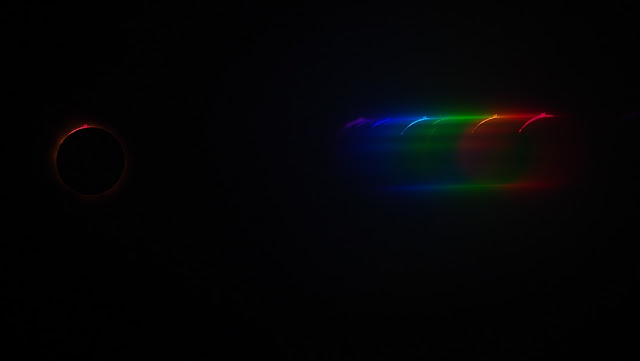Astronomia, astrofísica, astrogeologia, astrobiologia, astrogeografia. O macro Universo em geral, deixando de lado os assuntos mundanos. Um olhar para o sublime Universo que existe além da Terra e transcende nossas brevíssimas vidas. Astronomy astrophysics, astrogeology, astrobiology, astrogeography. The macro Universe in general, putting aside mundane subjects. A look at the sublime Universe that exists beyond Earth and transcends our rather brief life spans.
Pesquisar conteúdo deste blog
domingo, 3 de abril de 2016
O Flash do espectro do Sol | The Flash Spectrum of the Sun
Em um clarão, o espectro visível do Sol mudou de absorção para emissão em 9 de março, durante a eclipse total solar. Aquele momento fugaz, no inpicio da fase total da eclipse, é capturado por teleobjetivas e difração espalhando-se nesta imagem em céu claro sobre Ternate, Indonésia.
À esquerda, uma forte luz solar acaba de ser bloqueada pelo disco lunar. O normalmente distante espectro de absorção dominante da fotosfera solar está oculto. O que resta, espalhado pela difração que se espalha pelo espectro de cores para a luz do sol eclipsado, são imagens individuais da eclipse.
As imagems aparecem a cada comprimento de onda de luz emitida pelos átomos através do fino arco visível da cromosfera solar, e em uma enorme proeminência que se estende para além da borda superior do Sol.
As imagens mais brilhantes, ou linhas mais fortes de emissão cromosférica, devem-se a átomos de hidrogênio que produzem a emissão alfa vermelha de hidrogênio à extrema direita e emissões beta de azuis de hidrogênio, à esquerda. No meio, a imagem de emissão amarelo brilhante é causada por átomos de Hélio, um elemeno que spo veio a ser decoberto no espectro do flash do Sol.
Tradução de Luiz Leitão da Cunha
In a flash, the visible spectrum of the Sun changed from absorption to emission on March 9 during the total solar eclipse. That fleeting moment, at the beginning the total eclipse phase, is captured by telephoto lens and diffraction grating in this image from clearing skies over Ternate, Indonesia.
t left, the overwhelming light from the Sun is just blocked by the lunar disk. The normally dominant absorption spectrum of the solar photosphere is hidden. What remains, spread by the diffraction grating into the spectrum of colors to the right of the eclipsed Sun, are individual eclipse images.
The images appear at each wavelength of light emitted by atoms along the thin visible arc of the solar chromosphere and in an enormous prominence extending beyond the Sun's upper limb.
The brightest images, or strongest chromospheric emission lines, are due to Hydrogen atoms that produce the red hydrogen alpha emission at the far right and blue hydrogen beta emission to the left. In between, the bright yellow emission image is caused by atoms of Helium, an element only first discovered in the flash spectrum of the Sun.
Assinar:
Postar comentários (Atom)

Nenhum comentário:
Postar um comentário